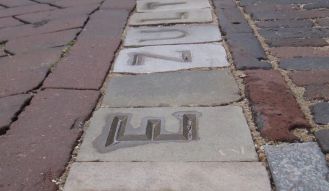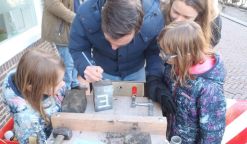
it began with the arrival of a letter when i was seven years old
with stamp on it that looked different from any i had ever seen
so beautiful and very exotic
and it came from my nana
who lived far away from michigan, in the exotic land of florida.
i thought that it was beautiful
and i decided then and there to become a stamp collector.
i cut that stamp from the envelope and glued it into a notebook.
not long after
i saw an offer to join a monthly stamp collecting club
in my archie comic book
and i noticed, as i went to send in the offer
that a parent had to sign it
so i asked my dad to give me his autograph on a piece of scrap paper
cut it out and glued it onto the form
(an early foray into my ill-fated attempts at a criminal career)
added in 99 cents from my piggy bank
and i was off to the races.
i eagerly awaited the day my first stamps would arrive
i had chosen some beauties and i ran home every day
hoping to find them in the mail
and on one glorious day – they were waiting for me!
i tore open the envelope
excitedly looked through them
licked them and placed them in my book
already looking forward to the next month’s arrival.
no one in my family was a collector
so i was taken by surprise when i showed them off to my friend’s older sister
who told me that real collectors only put them in cases
never touch them, and would never, ever lick them
– or they would instantly be made worthless!
i was quite taken aback
as it had never occurred to me that
this would be the reason people collected them
i had thought of them more as a collection of tiny beautiful pictures,
pieces of art, from places far away –
new guinea, finland, new zealand and even the legendary land of canada
i had chosen flowers, and children, and animals, and pretty designs
with no interest at all in old president’s heads, history, nor with any regard for value.
my version of ‘stamp collecting’ was simply collecting my favorites
and keeping them all in one place, in my special notebook.
i have always loved a mix of patterns and colors and collages of things.
the other thing i had not considered at all
was that i had no income
and would have to continue to pay in order to continue to receive stamps
the next month, when my new set arrived
i gathered more change together, put it in an envelope,
and of course it was never received.
they sent a new batch of stamps along with a due bill and i was panicked
still without any source of income
always waiting for them to show up at the door to tell my parents and to collect.
by the third month,
i simply collected envelopes that came from them
affixed with boring american stamps,
filled with letters, asking me to pay up
and my stamp collecting hobby fell by the wayside.
though i still have a great appreciation for beautiful stamps
and love licking them to put on handwritten letters that i send to places all over the world.
—
“synonyms for collectable postage stamps: “sticky treasures,”
“collection of paper heads,” “pretty bits of paper,” and “colorful scraps.”
-alan brandley – The Sweetness at the Bottom of the Pie
















